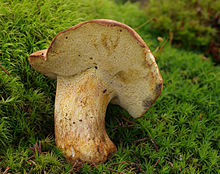Appendage tubular
| Appendage tubular | ||||||||||||
|---|---|---|---|---|---|---|---|---|---|---|---|---|

Appendage bolete ( Butyriboletus appendiculatus ) |
||||||||||||
| Systematics | ||||||||||||
|
||||||||||||
| Scientific name | ||||||||||||
| Butyriboletus appendiculatus | ||||||||||||
| ( Schaeff. ) D. Arora & JL Frank |
The appendage Boletus ( butyriboletus appendiculatus , syn. Boletus appendiculatus ), and Yellow Bronze Röhrling or Yellow Stone fungus called, is a very rare species of fungus from the family of Dickröhrlingsverwandten (Boletaceae). The mushroom got its name from an appendage, which is sunk into the ground at the base of the stem.
features
Macroscopic features
The cushion-shaped hat reaches a diameter of 6–15 (–20) cm. It has a fine felt to leathery and dry surface. The color ranges from ocher brown to maroon brown; Eating spots are yellowish to orange-pink in color. The edge of the hat is sharp and the hat skin can protrude a little. The tubes are briefly bulged on the handle and have fine, rounded pores / mouths. They are bright yellow in color, olive-yellowish with age and mostly blue at pressure points. The spore powder leaves an olive-brown imprint. The cylindrical, club-like stem is between 8-10 cm long and up to 4 cm wide. It is lemon yellow in color and has a fine-meshed yellowish to brownish network that also reaches the lower half of the stem. The hard and firm flesh ( trama ) has a pale or stronger lemon-yellow color and remains unchanged in the cut or only slightly blue. It smells pleasantly sour and tastes mild, slightly like nuts.
Microscopic features
The elongated-elliptical to spindle-shaped and pale yellow spores measure 10–16 × 4–6 micrometers.
Species delimitation
The coniferous forest or false appendage boletus ( Butyriboletus subappendiculatus ) is very similar . In contrast to the "real" appendage tubule, it grows exclusively in coniferous forests . In addition, it differs in its whitish flesh, which is only tinted yellow in the area of the bark, the clearly lighter tubes and the non-rooting stem base. It was not until 1979 that the mushroom was described as a separate species. It is often confused with different types of boletus . However, these only have yellowish tubes in old age, are completely white and do not blue.
Ecology and phenology
The appendage bolete can be found in deciduous forests , often on calcareous soil. It is a mycorrhizal partner of beech , oak and sweet chestnut .
The fruiting bodies appear in Central Europe from August to October.
distribution
The appendage bolete is a rare and heat-loving species. It has the same climatic requirements as the bronze bolete ( Boletus aereus ). Both species are rarer towards the north.
meaning
The attached boletus is considered an excellent edible mushroom , but in Germany it is protected according to the Federal Species Protection Ordinance and may not be collected.
swell
literature
- Franz Engel, Frieder Gröger: mushroom walks. A mushroom guide for everyone. 1989, ISBN 978-3-7403-0038-8
- Ewald Gerhardt: FSVO manual mushrooms . BLV, Munich 2006, ISBN 3-8354-0053-3 . P. 362
Individual evidence
- ↑ David Arora, Jonathan L. Frank: Clarifying the butter Boletes: a new genus, Butyriboletus , is established to accommodate Boletus sect. Appendiculati , and six new species are described . In: Mycologia . tape 106 , no. 3 , 2014, p. 464-480 , doi : 10.3852 / 13-052 .
- ↑ Boris Assyov: Boletus appendiculatus Schaeff. : Fr. In: boletales.com . Retrieved May 5, 2014 .
- ^ German Society for Mycology: The positive list of edible mushrooms. June 20, 2019, accessed August 2, 2020.
Web links
- Jaroslav Maly: Photo collection of pendants . On: Naturfoto.cz (en version)
- Georg Müller: Photo collection of an extension tube . In: picture gallery on pilzepilze.de
- The Rysch family: Photo collection of An Anängerröhrling . On: Homepage of the Rysch family
